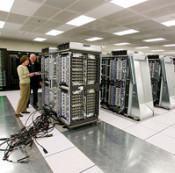
IT and society: Computer simulating the human brain to appear by 2019
The scientists are convinced that the constant increase of the amount of digital information and its complication are leading to the urgency of creation of the brand new type of computers, which will be able to scan the necessary and important data in the colossal information stream and carry it out with a great accuracy. In business such systems will be able to analyze a large amount of information and provide help in taking decision, claim the specialists of IBM.
The Blue Brain project at Swizerland's EPFL (École Polytechnique Fédérale de Lausanne) was launched in 2005 and aims to reverse engineer the mammalian brain from laboratory data. Among the specialists who are working under the project of cognitive computing systems (able to learn, not just to process data) are the fellows of IBM, specialists from Lawrence Berkeley National Lab (LBNB), Stanford University, University of Wisconsin-Madison, Columbia University Medical Center and University of California, Mercedes.
For the first time the scientists have managed to simulate the work of the mammalian brain known as the neocortex, which consists of 1 billion of neurons and 10 trillions of neuron connections between them. The mammals needed it because they had to cope with parenthood, social interactions and complex cognitive functions. To make the brain model come alive, the team feeds the models and a few algorithms into a supercomputer. One laptop is needed to do all the calculations for one neuron, so the scientists need ten thousand laptops. Thus the brain simulation has been carried out on the supercomputer Dawn, using the IBM Blue Gene/P design, located in the LBNB in Berkeley, California. This system was launched in April 2009 and entered the Top 500 list at 11th place among the supercomputers in the world. It consists of 147456 processors.
The scientists are sure that soon they will manage to decrease the size and the energy consumption of this computing system, able to perceive and process the information like the mammals do. Their long-term objective is to create the compact system, whose energy consumption will be lower compared to the modern systems of HPC class. The project is financially supported by the Defense Advanced Research Projects Agency of the USA (DARPA). “This initiative is aimed at creation of the brand new kind of electronic device, which will be able to understand and react to the infomedia like the brain does”, — comments the Director of the program Todd Hylton.
“The examination of the human brain model – is the best way to develop the computing systems, — considers the IBM honorary Fellow and Vice President of IBM Research — Almaden Josephine Cheng. — With the increasing amount of information and the significant role of computers in our daily life, it is reasonable to develop the computers which will be able to perceive the information the same way as we do”. A detailed, functional artificial human brain with the power and efficiency of the real one can be built within the next 10 years by 2019, claim IBM specialists.

